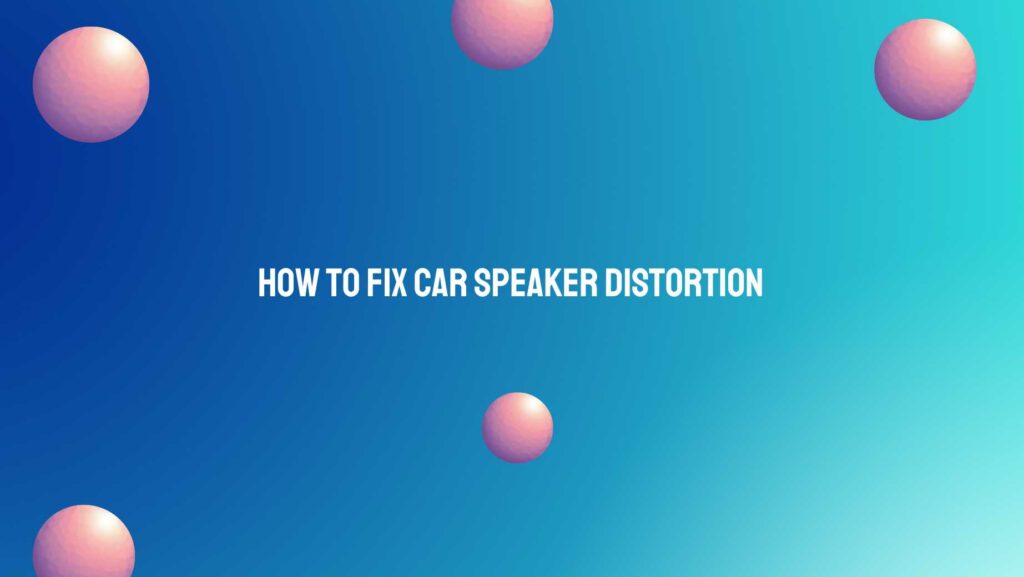Distorted sound from car speakers can be a frustrating issue for any audio enthusiast. It not only detracts from the listening experience but can also indicate underlying problems in your car’s audio system. Fortunately, many common causes of car speaker distortion can be diagnosed and resolved with some simple troubleshooting and maintenance. In this comprehensive guide, we will explore the step-by-step process to identify and fix car speaker distortion, restoring clear and enjoyable audio quality.
Step 1: Diagnosing the Distortion
Before attempting any fixes, it’s essential to identify the specific type of distortion and when it occurs:
- Type of Distortion: Determine whether the distortion is in the form of crackling, buzzing, rattling, or other anomalies. Different types of distortion may indicate different issues.
- Volume Level: Note whether the distortion occurs at low, moderate, or high volume levels. This information can help pinpoint the cause.
Step 2: Check the Volume and Equalization Settings
Often, distortion can be caused by incorrect amplifier or head unit settings. Here’s what to do:
- Reduce Volume: Lower the volume to a moderate level and check if the distortion persists. If it disappears, the issue may have been due to overpowering the speakers.
- Check Equalization: Ensure that the equalization settings (bass, treble, and balance) on your head unit or amplifier are correctly adjusted. Reset them to neutral settings if needed.
Step 3: Inspect Speaker and Enclosure
Physical damage to the speakers or their enclosures can lead to distortion:
- Speaker Inspection: Visually inspect the speakers for any visible damage, including torn cones, damaged voice coils, or loose components. Replace or repair damaged speakers.
- Enclosure Condition: Examine the speaker enclosures for damage, cracks, or leaks. Ensure that they are properly sealed and undamaged.
Step 4: Verify Amplifier Compatibility
Mismatched amplifiers can cause distortion. Make sure the amplifier or head unit is suitable for your speakers:
- Power Handling: Ensure that the amplifier’s power output matches or is lower than the speakers’ recommended power handling. Overpowering can cause distortion.
Step 5: Test Different Audio Sources
Distortion may be related to the source or the audio files themselves:
- Alternate Sources: Test different audio sources (CDs, radio, streaming, etc.) to see if the distortion persists. If it’s only present with one source, the issue might be in the source or its connections.
- Audio File Quality: Check the quality of the audio files. Low-quality or corrupted files can result in distortion. Try playing high-quality audio files to test.
Step 6: Inspect Wiring and Connections
Loose or damaged wiring and connections can introduce distortion:
- Check Wiring: Inspect all speaker wires and connections for any loose or damaged cables. Replace or reattach any faulty wiring.
- Clean Connections: Ensure that all connections, including the terminals on the amplifier, head unit, and speakers, are clean and free of corrosion.
Step 7: Consider Acoustic Treatment
If distortion persists, the acoustics of your car’s interior may be contributing to the problem:
- Sound Deadening: Consider adding sound deadening material to your car’s interior to reduce vibrations and improve sound quality.
Step 8: Seek Professional Assistance
If you’ve followed the previous steps and haven’t resolved the distortion issue, it may be time to consult a professional car audio technician. They can perform more in-depth diagnostics and repairs.
Step 9: Speaker Upgrade
If all else fails, consider upgrading your speakers to higher-quality models that can handle the power and provide clearer sound.
Conclusion
Car speaker distortion can be a frustrating problem, but it’s often solvable with careful diagnosis and troubleshooting. By following the steps outlined in this comprehensive guide, you can identify and fix the causes of distortion, ultimately restoring clear and enjoyable audio quality in your vehicle. Whether it’s adjusting settings, repairing damaged components, or seeking professional assistance, the goal is to ensure that your car audio system delivers the best possible sound experience on your journeys.


